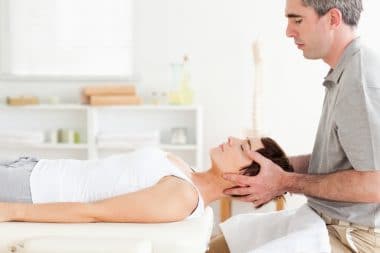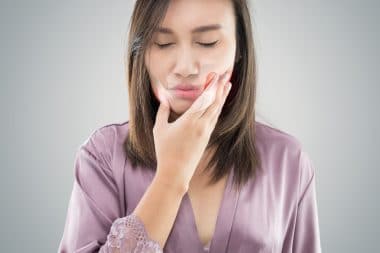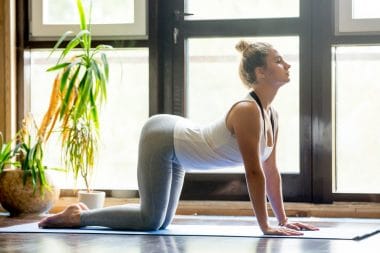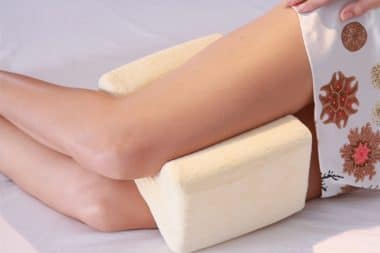If you are doing exercises without stretching and balancing, you are missing the flexibility component in your exercise programs. Flexibility gives you immediate and long-term benefits with fewer injuries and less pain. To help increase your flexibility as you age, work in balance and flexibility sessions every week. Three to six sessions a week would be very beneficial.
With every muscle toning or calorie burning exercises add one flexibility and stretching session. Stretching our muscles helps to relieve tension in your body and does help you feel good. Stretching and flexibility exercises can be a bit on the daunting side at first, and they do hurt just a bit, but with increased coordination you will be able to run on that treadmill, jog or live pain free.
What can Stretching do for You?
Finding it harder as you age to just bend over to tie your shoelaces? Is it difficult to move your head when backing out of parking spots? You are experiencing aging. Flexibility runs away as you age. There is a decrease in tendon strength in your body and tendons become more rigid. You muscles and joints have difficulty moving. Utilize stretching exercising as least three days a week to bring back your range of motion and provide flexibility. If you lift weights or do aerobic exercise it is essential you stretch to keep muscles from cramping and tightening up.
Stretching improves circulation to your arms and legs, muscle control, increases your sports performance, and escalates your balance and coordination. In addition stretching helps muscles recover quickly from injuries and exercise, adds to your range of motion and decreases the risk of injury. Want to improve your posture, self-esteem and self-confidence? Then stretch those muscles every day. Relax and invigorate your body and improve your overall health.
Limber Up!
Simply stretching in the morning goes a long way in getting muscles ready, blood circulating and time to focus on you. Stretch and you are now invigorated and ready for the day ahead. This is very necessary as you age. Stop the depression, the harm that passing time drops on your body and get up and stretch. A fun stretching exercise you can do just before getting up is:
- Lay on your back. Reach to your headboard, straighten your legs and imagine yourself being pulled from fingers to toes. Keep your feet flexed to prevent calf cramps and stretch. Hold this pose for at least three deep breaths, release, relax but don”t go back to sleep.
- On the edge of your bed, slump over your feet ” “ your natural pose when trying to get up ” “ from your lower back, roll to a sitting position. Roll your shoulders back and look straight ahead. Slowly, slump back into your first position. Do this a few times. Will stretch your back muscles.
Stretching is perfect for keeping those muscles limber and pliant during all ages. You also need balance to maintain physical fitness.
Balance for a Better Body
Men and women as they age tend to have poor balance, brittle bones, weak muscles and joints that just don”t flex. These problems will result in injuries that make it difficult in everyday living. Balance gives you the confidence to enjoy life, work every day chores and take up hiking, biking, or skiing.
There are small changes that happen in your body when you reach forty. The wavelike hairs in your inner ear lose sensitivity which in turn decreases balance. Your nerve cells are less sensitive and reaction times slow down.
You can maintain balance by utilizing resistance-training routines. Add these exercises into your regular fitness routine as often as you can. If you need to hold on to a wall for stability, gradually train your body to use only one hand, then one finger and then no props at all.
- Stand next to a wall, face sideways and your feet hip-width apart. Do not bend your knees but do shift your weight to your toes. Lean forward as far as you can without falling. Don”t let your heels come off the floor. Shift your weight back to your heels and move backward. Don”t lift your toes. Keep feet flat and sway to your left and then to your right. Bring your feet closer together, close your eyes and repeat.
- Try to touch your rear. Stand straight, and hold the back of a chair for extra balance. Flex your right knee and stretch your calf as close to the back of your thigh as you can. Hold. Lower the leg and repeat with the left leg.
Balance and Flexibility Programs
Keep your flexibility while you age by taking advantage of different programs that emphasize flexibility and balance. Try tai chi. This formal balance training uses strength training and flexibility. Tai chi is the starting point for martial arts experts, but can be modified for aging adults to increase flexibility. Rhythmic movements are slowly worked into the tai chi routines. Concentrate on the movement and how your body is moving to compensate for declining balance ability. Tai chi teaches participants that every movement is deliberate. Think about what you are doing. As you age, when you notice what you are doing and where you are going, you will be less likely to fall.
Yoga may seem overwhelming and slightly trendy, yet with any style of yoga improves your balance, flexibility and strength. Yoga is not just for the young and fit, but for every age. It release tension your body, quiets your minds and crates a feeling of ease. Do stay safe and follow the guidelines of a good yoga master. Adapt your yoga practice to your specific medical condition. Use the mind-body connection, self-acceptance and calming effect to find a perfect balance.
Find a yoga studio that offers Kripalu yoga. This instigates gentle and slow movements that stretch your muscles gradually. Sivananda yoga uses 13 poses performed in conjunction with supine relaxation or lying down. This type of yoga is adaptable to those of all abilities, ages, and medical conditions.
Whatever type of flexibility program you choose to integrate in to your exercise programs, keep it consistent. You can do simple stretching and balance exercise, chi tai, yoga or formalized balance programs. Visit your local gym to find out what programs they have for stretching and flexibility. Forget your age. You should utilize these programs at any age to keep yourself flexible, balanced, free from falls, injuries, and enjoy a healthy lifestyle.






